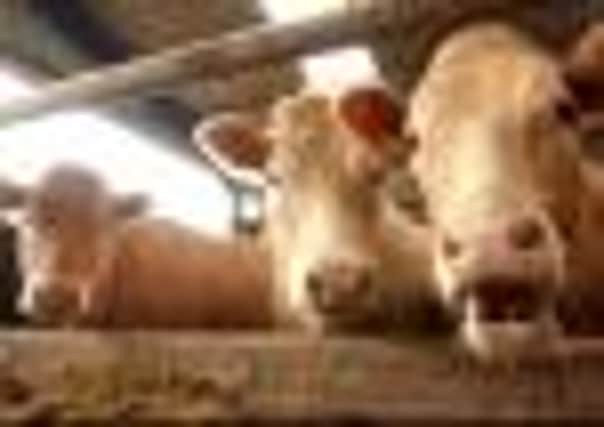Farming


World shortage means beef prices will remain high
STIRLING – United Auctions sold 5,915 prime sheep including 4,752 hoggs averaging 205.2p [sqq avg 219.9p] (+12.9p on week) and 1,163 ewes and rams. Hoggs sold to £120 and 262p, ewes to £138.50 and rams to £120. The firm also sold sold 2101 store cattle, young bulls and breeding cattle, 196 cast cows and 390 store and breeding sheep. Bullocks (1,192) averaged 223.51p (-10.85p) and sold to 287.5p and £1,350. Heifers (761) averaged 217.86p (-9.26p) and sold to 257.6p and £1,310. Young bulls (148) averaged 187.94p and sold to to 237.4p and £1,140. Cast cows (164) averaged 142.21p and sold to 205.3p and £1,770. Forward cattle (32) averaged 178.34p and sold to 207.9p and £1,290. OTM cows sold to £1,770 or 205.3p, OTM bulls to £1,790 or 155.7p. Breeding cattle: heifers and calves sold to £2,480, cows and calves to £1,350, in-calf to £1,500. Store and breeding sheep (390). Hoggets sold to £74, grit ewes to £139.
THAINSTONE – Aberdeen & Northern Marts sold 219 OTM cattle. Beef cows (182) averaged 152.1p and sold to 205.3p and £1,555. Dairy cows (28) averaged 136.6p and sold to 168.5p and £1,225. Farrow bulls (nine) averaged146.5 p (+13.6p) and sold to 158.8p and £1,730. The firm also sold 63 prime cattle. Under 30 month - prime bullocks (ten) averaged 199p (-3p) and sold to 218p and £1,534.35. Prime heifers (30) averaged 197p (-1.7p) and sold to 223p and £1,362.50. Young bulls (12) averaged 173.6p (+9.9p) and sold to 199p and £1,428.20. 30 to 48 Month - Bullocks (four) averaged 187.3p (-5.8p) and sold to 191p and £1,503.60. Heifers (seven) averaged 185.4p (-12.8p) and sold to 199p and £1,402.50.
Advertisement
Hide AdAdvertisement
Hide AdSTIRLING – Caledonian Marts sold 197 live cattle at their weekly primestock sale comprising 99 bullocks and heifers, 12 young bulls, 12 OTM clean and 74 cast cows and bulls. Bullocks (46) averaged 211p and sold to 227.5p (twice) or to £1,582. Heifers (53) averaged 208p and sold to 238.5p (twice), or to £1,396. Butchers cattle (24) sold in excess of 220p to average 226.5p and selling to 231.5p. Young bulls (12) averaged 201p or £1,430,selling to 218.5p or to £1,751. OTM clean cattle (12) sold to 196.5p or to £1,568. Cast cows, bulls and OTM cattle (86) - Char bull sold to £1,500, Lim cow sold to £1,385. Calves and stirks (55). Calves sold to £300, stirks to £560.
AYR – Craig Wilson Ltd sold 707 store cattle. Beef bullocks (368) averaged 229.9p or £856.07, 227 beef heifers averaged 216.4p or £804.87, 112 Friesian bullocks averaged 177.1p or £782.03. Bullocks sold to £1,310 and to 290.4p, heifers to £1,150 and to 245.8p. The firm also sold 286 store and breeding sheep. Store hoggets sold to £79.50, ewes with lambs at foot sold to £174.
Land values are on the rise says Savills’ Dudgeon
Beef farmers were assured this week by Stuart Ashworth, the head of market intelligence at Quality Meat Scotland, that prices would continue to remain firm for the next couple of years.
Speaking at Stirling, Ashworth said it was all down to a tight supply of cows and calves in the production chain. Part of the shortage has been accentuated by the recent high culling rates in the beef sector.
“There is little prospect of significantly more cattle appearing over the next couple of years so the tight supply will remain,” he said, adding the shortage existed throughout the world with low stock numbers pushing the price upward.
He gave as an example the fact that cattle numbers in the USA, one of the world’s biggest beef traders, were significantly down as a result of the drought in 2011.
This worldwide shortfall would limit where alternative supplies could be sought by domestic and international buyers.
“There is a tight supply situation everywhere, so prices will remain firm; there will be no cheap beef for the EU market,” he said.
Advertisement
Hide AdAdvertisement
Hide AdHowever, he warned that consumer confidence remained fragile so farmgate prices might be constrained by consumers’ willingness to pay higher retail prices.
Speaking at the same meeting, Sandy Hay from the Bank of Scotland stressed the need for more efficiency in production.
“The rise in beef price since August 2009 has been around 25 per cent; over the same period feed wheat prices have increased by 76 per cent, so what can farmers do to capture the value that we’re seeing in rising sale prices, whilst insulating yourselves from these increases in input costs?”
For him the answer lay in production efficiency which equated to business efficiency. That gave the bank’s enhanced confidence in lending to farmers who were looking to capitalise on the undoubted domestic and export opportunities in the beef sector.
Tight supply of beef cattle meant stable prices ahead
Five years ago when the economy was booming, the value of a farm house was a significant factor whenever farms came on to the market. Now that has changed, with a leading land agent stating the big selling point was land, and top quality arable land at that.
Speaking in Edinburgh, Charles Dudgeon of Savills said the interest in this type of land did not just come from neighbours hungry to add to their own acreage but also from many outside the farming industry.
“If you buy top class arable land, you can soon get someone in to contract farm it on your behalf,” he said after saying that one East Lothian farm had attracted interest not only from neighbours but also from a football agent and a prominent Queens Counsel.
The very best of land has gone up in value by more than 5 per cent last year and the gap between its value and poorer soils is widening rapidly.
Some blocks of such top land were now being traded at over £10,000 per acre, although he said the average figure for prime arable land last year was about £6,500 per acre.